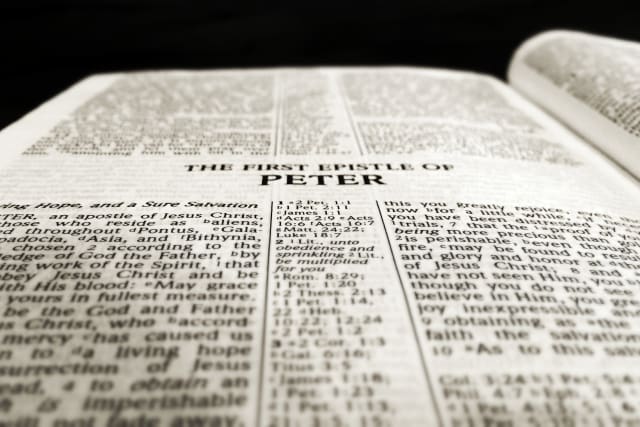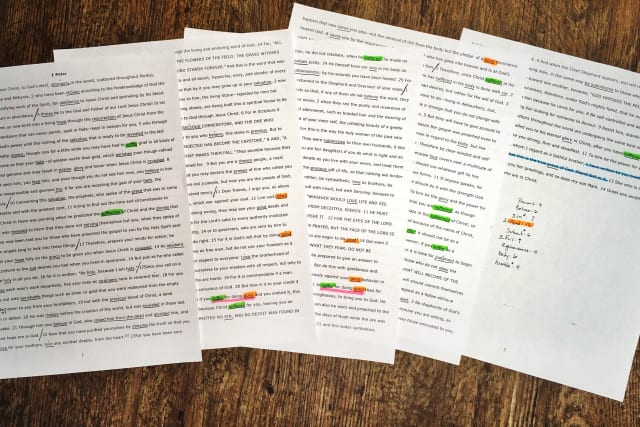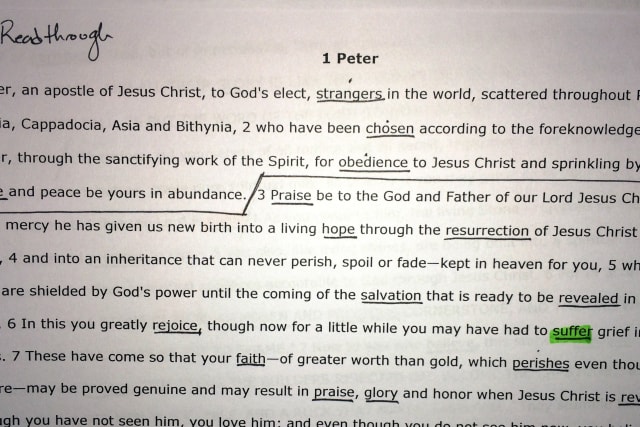
by Matt Lantz

This is the third post in a series of articles that outline some basic steps to practice in studying the Bible. For a list of all the posts, click here.
Once I have read the book three times, I’ll use the information I gathered while reading through the book and begin the process of discerning an outline.

So, the objective here is to work in reverse. I have the written letter from Peter. If he would have used an outline, what would it have looked like? Outlining the book will help me think through the logical flow of Peter’s argument and how he uses his themes to emphasize his main idea to his readers. There isn’t one “right” outline for any book, but the process really helps me understand where the passage I’m studying fits into the larger context of the letter it comes from.
First, I compile my observations from my read-through.
Some of the major things I notice when I read through the book three times are words that are consistently repeated throughout the letter, themes that are emphasized, and explicit statements of purpose. In the case of 1 Peter, I noticed the words “good” and “suffer” were repeated the most (13x and 18x respectively) in the NIV’84 version. I also thought that the explicit purpose of the letter was stated in verse 12 of chapter 5:
“I have written to you briefly encouraging you and testifying that this is the true grace of God. Stand fast in it.”

As I read, I also noticed where the major shifts in thought occurred – especially in connection with some of these repeated/emphasized themes and words.
Then, I read the entire book a fourth time and mark all the major divisionsAfter my fourth read-through, I felt fairly certain that there are four major divisions in the book. The first is after the introduction (1:1-2). The second is between verses 10 and 11 of chapter 2. Third, I noticed that most of the first two chapters are identity focused whereas most of the latter chapters are more activity focused. The final section is the conclusion (5:12-14). Thus, my outline looks like this:
I. Introduction (1:1-2)
II. Part 1 (1:3-2:10)
III. Part 2 (2:11-5:11)
IV. Conclusion (5:12-14)
On my worksheet, I mark all major divisions as solid black lines across the page.

Next, I read the book through a fifth time and mark all of the sub-divisions.
The fifth read-through focuses on the sub-sections within each of the major divisions. As I read through this time, I’m looking for the specific points of thought that make up the larger argument. As I notice a change in thought, I make a black slash between the end of one verse and the beginning of the next. My outline then expands and looks like this:
I. Introduction (1:1-2)
II. Part 1 (1:3-2:10)
A. Sub section 1 (1:3-12)
B. Sub section 2 (1:13-25)
C. Sub section 3 (2:1-10)
III. Part 2 (2:11-5:11)
A. Sub section 1 (2:11-12)
B. Sub section 2 (2:13-3:12)
C. Sub section 3 (3:13-5:11)
IV. Conclusion (5:12-14)
Finally, I read through the book a sixth time and summarize each of the sections with a 2-3 word description.
This read-through might be the most helpful step in the early stages of study. For each of the major sections and sub sections I find, I look at the entire section and try to decide on a 2-3 word title that best summarizes what that section is about. If I could summarize each one of these sections in my own words, what would I say?
These divisions and titles that we make here will most certainly change as we do more in-depth study. This part of the process, however, helps us grasp the entire message of the book and see how the whole letter functions. Ideally, this should give us all the context we need to be able to more effectively study our passage.
Thus, the first draft of my outline of the book would look something like this:
I. Introduction & Greeting (1:1-2)
II. The Theological Identity of the Community of Faith (1:3-2:10)
A. We are born again (1:3-12)
B. We are obedient children (1:13-25)
C. We are a holy priesthood (2:1-10)
Etc., etc., etc.
Sometimes I’ll even further subdivide the parts into smaller wholes like this:
I. Introduction & Greeting (1:1-2)
II. The Theological Identity of the Community of Faith (1:3-2:10)
A. We are born again (1:3-12)
i. Our inheritance is permanent – giving hope (1:3-5)
ii. Our joy is complete – giving endurance (1:6-9)
iii. Our new birth is marvelous – giving revelation (1:10-12)
B. We are obedient children (1:13-15)
Etc., etc., etc.

So, before I’ve even begun to study the selected Text, I’ve read the book at least six times and established my preliminary understanding of the logical argument of the book itself. This gives me a helpful context wherein I can begin to research the cultural background of the Text. We’ll get to that next time.
Posted Nov 10, 2014
Categories: Spiritual (Browse all)
|
Tags: bible, matt lantz, scripture, series, studying the bible
Click here to sign up for our Inside the Cove newsletter!